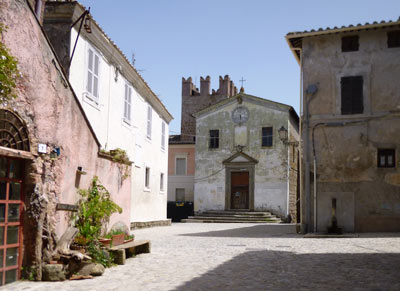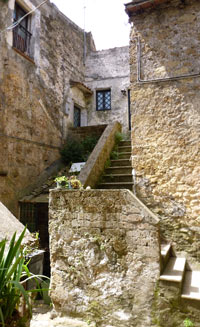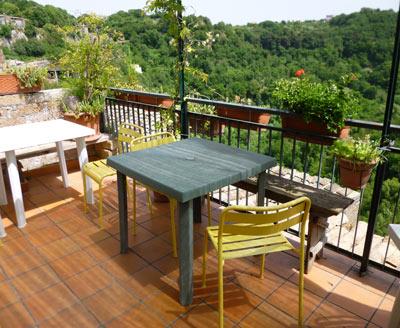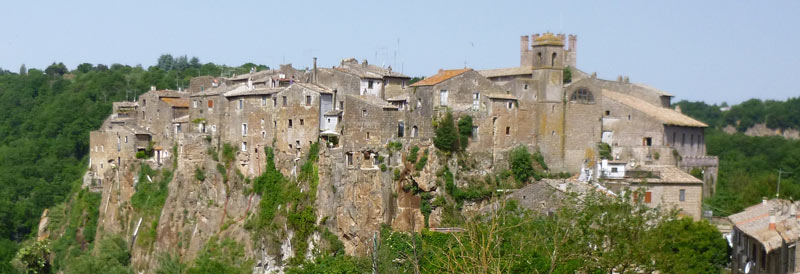The picturesque village of Calcata is perched on a rocky outcrop overlooking a wooded valley around thirty miles north of Rome. Re-settled by artists, the small medieval settlement is a low-key attraction which offers a taste of an alternative Italy. An interesting off-the-beaten-track destination for a day trip, or a sight to visit when touring the region of Lazio, Calcata is visited by occasional tourists and by Romans enjoying a Sunday excursion. An infrequent public bus service links Calcata with Rome.
Calcata tourist information

In many ways Calcata is a very typical Italian borgo, or hill town. There are lots of similar villages in rural Italy, many of them in the Lazio region around Rome. Built on crags for defence in the turbulent Middle Ages, these settlements began to decline and lose their populations over the course of the twentieth century. Tight-packed, decrepit, impoverished, often suffering from erosion, poor communications and general inconvenience, they couldn’t compete with the opportunities offered by Italy’s modern towns and cities. Visiting these sleepy villages is an atmospheric experience, like a trip back in time.
If you are choosing a forgotten village to visit, Calcata has more to offer the visitor than most. In the 1930s Old Calcata, Calcata Vecchia, was abandoned on safety grounds; there were fears of the crags crumbling away. A new village (Calcata Nuova) was built on a higher plateau close by. But a few decades later the crumbling old settlement was rediscovered by a new type of inhabitant. Artists and creatives from Italy and overseas began to make their homes in the historic buildings, restoring ruins and bringing the ancient village back to life as a kind of bohemian idyll. Nowadays the village still has some of the sleepy atmosphere of an abandoned village. But while some buildings are still very down-at-heel, there are flower pots in the alleys, revitalised dwellings and reclaimed spaces. The visitor will discover artists’ studios, cafes and unpretentious little restaurants. Calcata is a long way off being a slick tourist attraction – at the time of writing, anyway. Visit during a weekday and you’ll find stray cats dozing and the alleys empty. But come lunchtime, holidays and weekends, doors and shutters open and you’ll find galleries to visit, homespun cafes to drink at, and local food to enjoy. As a destination it offers a good balance between authenticity and visitor-friendliness.
Calcata is within the Parco Regionale Valle del Treja, a regional park which covers the mostly-wooded territory around Calcata and neighbouring Mazzano Romano. The park incorporates ancient archaeological sites and nature trails, and organises occasional events. There’s a park office in Calcata which hosts exhibitions and where visitors can pick up information leaflets (it also has a handy toilet).
Calcata is built onto and into the rocks, and entering on foot it is easy to imagine the village’s past as a walled citadel. The way into Old Calcata is through a stone gateway and a narrow crooked passage which leads up into the town’s piazza. The Palazzo Baronale to the right, housing the office of the Parco, is the most substantial building in town. Outside three carved stone thrones, by sculptor Costantino Morosin, stand like a proclamation of Calcata’s off-beat artiness. Close by is Calcata’s small church (once supposed to house the sacred relic of the foreskin of Jesus, now mysteriously vanished). Not far away is a small museum of rural life (open on holidays and by request). Several alleys lead to viewpoints on the edge of the crags, looking over woodland and the odd ruin. Some of Calcata’s houses are built right into the rock, forming cave-dwellings.

Calcata is very small and you can explore its lanes in a matter of minutes. Bus travellers who have hours to spend here might consider bringing a book, a camera or sketchpad, or whiling away time on a café terrace. A trail heads downhill from just outside the town into the wooded valley below. Another pleasant walk leads uphill to the modern village, and offers a nice way to get a gentle taste of the countryside. Head upwards through the old farmhouses on the slope facing the village, and take a lane which heads to the right. This passes picturesque old buildings, viewpoints over Calcata and old caves cut into the rock, now used as sheds and garages. As the path climbs upwards you get a taste of the rural landscape, before the path reaches a car park outside the modern part of Calcata.
There is a little bar in Calcata, close to the park office, and another bar just outside the town, near the bus stop. Other businesses in town are more informal and have shorter opening hours, with restaurants and cafés more likely to be open at weekends and public holidays. One of the nicest places in town is La Sala, a tearoom offering 101 types of tea, including refreshing iced tea on a hot day, as well as cakes. The central Caffè Kafir is a colourful and eccentric place for a snack or glass of wine surrounded by artefacts, film posters and artworks by the proprietor, a film actor-turned-artist.
A short distance from Calcata Vecchia is Opera Bosco, an outdoor woodland art-museum (limited opening, admission charge). The story of Calcata and the disappearance of its special relic is told in An Irreverent Curiosity: In Search of the Church’s Strangest Relic in Italy’s Oddest Town by David Farley.
Although there is not a great deal to do or see in Calcata, it makes a refreshing break from the turmoil of Rome, and, as an example of Italy’s abandoned hill towns, it offers an insight into a different Italy.
Travel, accommodation and practicalities

Calcata is most conveniently visited by car, enabling visitors to spend as much or little time here as they choose, and combine the village with other sights in the area. However, it is also a practical destination for a day trip from Rome by public transport – as long as you are prepared to plan your day around the bus timetable (which may mean an early start and half the day in Calcata).
Driving: From Rome, take the SS2bis towards Viterbo, turning off at the exit for Mazzano Romano. There is a limited amount of parking at the entrance to Calcata. A good-sized car park can be found up the hill by the modern settlement, Calcata Nuova; there is a pleasant pedestrian footpath leading from the car park to the old town.
Public transport: Buses from Rome to Calcata are operated by Cotral and depart from Saxa Rubra, a bus station on the outskirts of the city. Saxa Rubra is reached by taking a local train (Roma-Civita Castellana-Viterbo line) from Flaminio station, which is adjacent to the Flaminio metro stop, by Piazza del Popolo (Rome travel cards are valid for this part of the journey). Allow at least twenty minutes for this leg of the journey. Timetables for these trains can be found on the ATAC website (see links panel on the right). At Saxa Rubra buy your bus tickets from a news-stand or ticket office – buy your ticket for the return journey here too, as there is no ticket point in Calcata (fares were 3.40 euros each way at the time of writing). Ask which is the correct bus as Calcata may not be advertised as a destination. Ask the bus driver for Calcata Vecchia. You can’t miss the village: you’ll see it perched on its crag to the left of the road. The bus stops just before the village; the return stop is opposite, though unmarked. The journey takes from 45 minutes, though it is dependent on traffic.
Note that transport details are correct at the time of writing, but it is always a good idea to confirm the latest when you travel. The latest bus timetable link is here: Calcata timetables. Note that da means from and per/verso mean for/to. Typically there is an early morning bus from Saxa Rubra (9.20am when I visited) and the first return bus is after lunch (2.55pm).
There are very few services and marks of modernity in Calcata. Visitors should arrive with cash, as there is no cashpoint or bank.
In Calcata there are a few rooms and apartments to let privately. Otherwise, accommodation options around Calcata are limited. Visitors who are touring the area by car may consider staying in a countryside B&B or in a nearby town such as Civita Castellana (on the bus and rail routes from Rome), north of Calcata.
> Hotels, B&Bs and holiday homes in and around Calcata
On this site
Visiting Calcata – blog and photos
If you like Calcata, you may like
Useful external links
Parco Regionale Valle del Treja
Lazio destinations
- About the Lazio region
- Anzio
- Bracciano
- Calcata
- Castel Gandolfo
- Castelli Romani
- Cerveteri
- Formia
- Frascati
- Gaeta
- Palestrina
- Pontine islands
- Ponza
- Rome
- Sperlonga
- Terracina
- Tivoli
- Ventotene
- Viterbo
